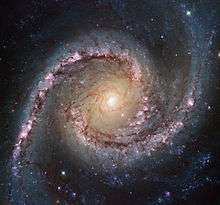NGC 1566
| NGC 1566 | |
|---|---|
 A close-up image of NGC 1566 taken by the Hubble’s Wide Field Camera 3. | |
| Observation data (J2000 epoch) | |
| Constellation | Dorado |
| Right ascension | 4h 20m .4s[1] |
| Declination | −54° 56′ 16″[1] |
| Redshift | 0.005017[1] |
| Helio radial velocity | 1504 ± 2 km/s[1] |
| Distance |
38.4 ± 18.6 Mly (11.8 ± 5.7 Mpc)[2] |
| Apparent magnitude (V) | 10.3[1] |
| Characteristics | |
| Type | SAB(rs)bc[1] |
| Apparent size (V) | 8′.3 × 6′.6[1] |
| Other designations | |
| PGC 14897[1] | |
NGC 1566, commonly known as the Spanish Dancer [3][4] is an intermediate spiral galaxy in the constellation Dorado. It is the dominant[5] member of the Dorado Group and also its brightest member.[6][7] It is one of the brightest Seyfert galaxies in the sky.[5] Its absolute luminosity is 3.7×1010 L☉.[8] It contains 1.4×1010 M☉ of H I.[8]
SN 2010el
On June 19, 2010, Berto Monard from South Africa detected a magnitude 16 supernova 13" west and 22" south of the center of NGC 1566 at coordinates 04 19 58.83 -54 56 38.5.[9]
References
- 1 2 3 4 5 6 7 8 "NASA/IPAC Extragalactic Database", Results for NGC 1566, retrieved 2007-04-01
- ↑ "Distance Results for NGC 1566". NASA/IPAC Extragalactic Database. Retrieved 2010-06-21.
- ↑ "Spanish Dancer Galaxy - NGC 1566 - Billions and Billions.com". billionsandbillions.com. Retrieved 2015-10-13.
- ↑ "NGC 1566 Spanish Dancer Galaxy in Dorado | Amazing Sky Astrophotography by Alan Dyer". amazingsky.photoshelter.com. Retrieved 2015-10-13.
- 1 2 de Vaucouleurs, Gérard (April 1, 1973), "Southern Galaxies.VI. Luminosity Distribution in the Seyfert Galaxy NGC 1566", Astrophysical Journal, 181: 31–50, Bibcode:1973ApJ...181...31D, doi:10.1086/152028
- ↑ Huchra, John Peter; Geller, Margaret J. (June 15, 1982), "Groups of galaxies. I - Nearby groups", Astrophysical Journal, 257 (Part 1): 423–437, Bibcode:1982ApJ...257..423H, doi:10.1086/160000
- ↑ Firth, P.; Evstigneeva, E. A.; Jones, J. B.; Drinkwater, M. J.; et al. (November 2006), "Kinematics, substructure and luminosity-weighted dynamics of six nearby galaxy groups", Monthly Notices of the Royal Astronomical Society, 372 (4): 1856–1868, arXiv:astro-ph/0608584
 , Bibcode:2006MNRAS.372.1856F, doi:10.1111/j.1365-2966.2006.10993.x
, Bibcode:2006MNRAS.372.1856F, doi:10.1111/j.1365-2966.2006.10993.x - 1 2 Virginia A. Kilborn; Bärbel S. Koribalski; Duncan A. Forbes; David G. Barnes; et al. (January 2005), "A Wide-Field Hi Study of the NGC 1566 Group", Monthly Notices of the Royal Astronomical Society, 356 (1): 77–88, arXiv:astro-ph/0409743
 , Bibcode:2005MNRAS.356...77K, doi:10.1111/j.1365-2966.2004.08450.x
, Bibcode:2005MNRAS.356...77K, doi:10.1111/j.1365-2966.2004.08450.x - ↑ David Bishop. "Latest Supernovae". supernovae.net (International Supernovae Network). Retrieved 2010-06-21.
Coordinates: ![]() 04h 20m 00.4s, −54° 56′ 16″
04h 20m 00.4s, −54° 56′ 16″
External links
| Wikimedia Commons has media related to NGC 1566. |
- Spitzer Space Telescope page on NGC 1566
- Discovery image of SN 2010el (2010-06-19; The star to the left of the core of the galaxy is magnitude 12.3)
- NGC 1566 on WikiSky: DSS2, SDSS, GALEX, IRAS, Hydrogen α, X-Ray, Astrophoto, Sky Map, Articles and images
This article is issued from Wikipedia - version of the 10/13/2015. The text is available under the Creative Commons Attribution/Share Alike but additional terms may apply for the media files.